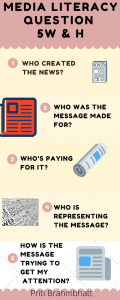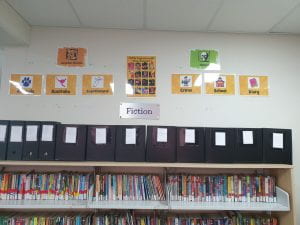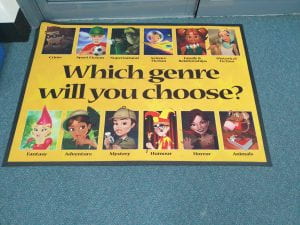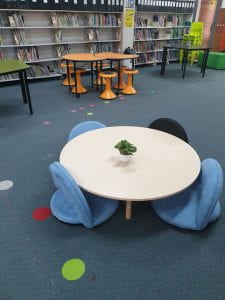Part A
Statement of personal philosophy
21st century education is about creativity, cultural awareness, problem solving, innovation, civic management, communication, productivity, collaboration, exploration, initiative, leadership, making classrooms dynamic. An effective teacher Librarian’s will continue to foster a recreational reading culture by building a passion for print, eBooks, graphic novels and audio books in all readers from struggling to gifted. 21st century library is building learning through literacy and technology. Educators are constantly developing newer and better ways to teach. Yet they’re stuck in obsolete spaces that prevent them from giving students the best. Designing each space for a different type of experience – rather than a subject or teacher – will allow schools to curate far more powerful experiences by virtue of having environments that are more supportive and far more compelling to be in.
Part B
Theme 1: Genrefication
Teacher librarians need to set up their collection in a manner that is accessible to students as the availability and accessibility of collection in a library encourages students to read. The question then arises, how this can be achieved? The answer is Genrefication. I was introduced to this term in ETL 505 (Describing and Analysing Resources).
According to Wall (2019), Genrefication just means organising books, either fiction or nonfiction, by category in a scheme other than DDC or general alphabetical order. Some librarians believe that the tried and true system of shelving alphabetically by author surname is the best way to shelve fiction; others believe that by genre shelving they can encourage students to read more. A third group prefer a middle ground, where author arrangement and genre stickers combine to promote exposure to different titles as well as independent access. When the collection is classified by genre into a catalogue, a teacher librarian can identify the most popular genre as well as each genre’s most popular books. It makes it far easier, for example, to find the most popular horror books. It will enable in making the right decision making for purchasing new books.
The inspiration for genrefication project came from ETL 505. I got really interested in this topic and decided to put this into my practice. I started with arranging the fiction from the middle ground and so I approached my principal. I was fortunate to get a positive reply. School Catalogue Information Service (SCIS), National Library of Australia and Department of Education SCAN articles were really helpful in this process.
SCIS pre-determined Genre Headings were used to identify the genre of the book. Genre stickers were then placed on the spine label will be beneficial. Students were educated regarding the genres in the library through explanation, power point presentation and displaying genre posters. It has also encouraged students to read more as they enjoy what they are reading and at the same time find variety of similar titles in their favourite category. The purpose of genrefication is to enhance students’ ability to browse a library collection without staff or technological assistance. The teaching program for each school library should always include awareness and developing skills on how to use a library catalogue or to locate information.
On the other side, it was noticed that students were limiting themselves to one kind of genre and were not experiencing different genres. National Library of New Zealand (2020) suggests that students might be encouraged to keep track of their reading life with a log, which records what they read and from which genre and teachers could encourage students to try a different genre, and possibly even require at least a few titles from each genre over the course of a year. Following this advice, a genre wheel was introduced, where students can read five books from one genre and then they had to move to a different genre.
Generifying fiction was the best thing I ever did as my borrowing rates have jumped and what’s more, I believe some of the kids are actually reading wider. Students will be self-selecting books with greater ease and the resources will be more engaging. To bring this change in school libraries, the role of teacher librarian has to make all the stakeholders aware of the changes and also to educate the students through posters, talks and other displays with genre information and title examples. This has assisted readers in finding the right book at right book, providing guidance in trying new authors, themes and genres and providing reading, literacy and library use. However, it is considering cultural and ethical understanding is necessary before generifying. Currently our nonfiction is based on Dewey Decimal classification. I have read about schools getting rid of non- fiction section, but I believe that completely getting rid of print non-fiction in primary school is not a good idea.
Theme 2: Teacher Librarian as a leader
The role of teacher librarian is often not noticed. In my first blog post in ETL 401, I really undermined the role of teacher librarian. However, over a period of time through this course, my opinion has completely changed. I have understood the different hats a teacher librarian wears.
ETL 504: Teacher librarian as a leader has inspired me to think one step further. Teacher librarian also wears a hat of a leader, and leads from the middle. AASL’s guidelines (2009, p. 45) states that the school library program is “built by professionals who model leadership and best practices for the community to ensure that learners are equipped with the skills and knowledge they need to succeed in the technological society of the 21st century”. Teacher librarians works from the library but leads within and beyond the library. Taking on a leadership role in the school means making the library visible and an integral part of the teaching and learning in the school. To achieve this goal, a teacher librarian need to collaborate with staff. This type of leadership is often called as leading from the middle.
Teacher librarian uses instructional leadership by providing professional development and empowering and involving teachers to lead innovation and change. To embrace change positively, it should be introduced with understanding, direction, commitment, time and resources. I will always remember the 3 c’s I have learnt in ETL 504. They are collaboration, communication and connectedness. According to Colvin (2000), 21st Century teachers and librarians will be valued for their ability to create, judge, imagine and build relationships. I have understood that it is extremely important for a teacher librarian to build a rapport with the students and the teachers to make the library and librarian visible.
Another way of achieving this is through advocacy. A teacher librarian mentors and fosters the school through student leadership body and also acts as a coordinator for National reading programs such as Premier’s Reading Challenge (PRC). At my current school, I am the coordinator of PRC program for K-9 students. I contribute in the school newsletter and keep the school community informed about the library happenings. The school community should be familiarise with the campaign such as School libraries matter.
This subject also emphasised that the learning environment is also a key force that foster and facilitate active, authentic and relevant experiences that embrace critical thinking and problem solving. This can be done by providing exciting, dynamic learning space in the library such as flexible seating and maker space in the library. In my ETL 504 assessment 2, I have discussed the need for flexible seating and makerspace and how it enhance the use of library space. The learning space should be designed to accommodate flexible academic groupings, different levels of independence, and collaboration between mixed-age groups. I have implemented flexible seating in my library however due to limited space in library, makerspace is still on my list of agendas. Makerspace is about teaching students more than just how to use technology but how it can transform students’ learning and thinking.
ETL 504 also consisted of group work and case studies. The actual case study scenarios themselves have broadened my awareness of potential issues that will assist me in making informed future practice and leadership directions. I have developed my knowledge and understanding of teacher librarian as innovators, mentors, motivators, entrepreneurs, catalysts, and illuminators. We are reading specialists who provide leadership in emerging areas such as multi- function digital platform. We continue to foster a recreational reading culture by building a passion for print, eBooks, graphic novels and audio books in all readers.
Teacher librarians are rarely members of the top executive tier in a school. Despite carrying out all the responsibilities of a middle leader because of the stereotype, I still believe that it is a long way for all the stake holders to consider teacher librarian as leader. This type of stereotype is harmful, because the information landscape is now more complex than ever before and the teacher librarian’s role has extended beyond the physical collection and into the virtual world.
Theme 3: Digital Citizenship in Schools
Libraries struggle to justify themselves in the age of google. There are many who believe libraries are no longer necessary, I am of a strong opinion that libraries and teacher librarians are necessary than ever before as they are the experts who can teach children to be safe and productive in the digital world.
The Australian School Library Association (2013) identifies the significant contribution teacher librarians can make within their schools and networks by approaching the challenges of addressing a 21st century teaching and learning agenda. We live in an era of rapid change and innovation. Students in 21st century should learn to think critically, check facts, interpret and evaluate all the information they receive. The school library enhances student learning outcomes by providing a range of programs, services and resources which support teaching and learning. This also include digital citizenship program. It would be totally incorrect to assume that students are digital natives. I will ensure that digital citizenship becomes a prominent part of my teaching programs. I have already taken Top of Form
the first steps toward joining Common sense network of innovative educators, schools, and districts who are making digital citizenship a part of their classroom and school cultures. Students will use digital technology and tools more meaningfully, make good choices and informed decisions.
My school has a very little concept of digital learning environments. Hence, the biggest step as a result of my study is, I have understood how vital it is to teach digital citizenship to students. As a result of ETL 523: Digital citizenship in schools, I have registered myself to attend the online training for teaching Digital Citizenship run by Common sense media for educators.
The library should offer print and electronic resources that are age appropriate and according to the ability of the students. With changing times, it is so important to give students exposure to variety of digital texts such as eBooks, enhanced eBooks and interactive books. One of the biggest questions facing school libraries at present is what impact digital content and changing publishing models will have on collection. Currently, the school I work at has no eBooks, but a proposal is already made to the management for eBooks and we have received trial for World Book Online till November. I am already feeling positive about it.
ETL 523 has strongly inspired me to promote and nurture a ‘whole school focus’ on information literacy policy and implementation (ALIA, 2004). Coteaching and working alongside with all key stakeholders can be key contributors in cocreating a vital system of bringing change, trust and support. This program will prepare young people not only to become informed and watchful citizens but also to promote their participation in civic life through internet-based volunteering, campaigning and lobbying (Greenhow, 2010). The whole school approach will help identify the potential opportunities, challenges and likely future development relevant to the school.
ETL 523 introduced me to digital tools such as Canvas, Powtoon, Padlet and Weebly. This is an example of infograph made using Canvas. Now I am confident using it. Weebly was done as a group. Our topic was evaluating information for reliability, accuracy, credibility, and perspective and media literacy. My part was to discuss credibility and media literacy. I will also use Canvas for my INF 533 assignment on digital story telling.
 |
 |
The group work was a positive experience and it is also mentioned in my ETL 523 blog 1. Here is the link to the website https://evaluatinginformation.weebly.com/
I will use my professional expertise that I have gained throughout the course to identify a range of print and digital curriculum that the students can use in information gathering, note taking, copyright and the impact of digital footprints.
The key takeaway from this subject was for digital learning environment management is shared by Lindsay & Davis (2012) is ‘Stop, Screenshot, Block, Tell, and Share.’ This strategy works within a single class setting or in an online global collaboration. I will focus on working with teachers in areas such as information literacy, information technologies, cooperative planning and teaching and curriculum development as well as developing and maintain collection that will meet the needs, interests and abilities of the school community. This will help me achieve my ultimate goal to develop independent learners who know how to expand their knowledge and expertise through skilled use of variety of information sources employed inside and outside school.
Part C (500 words)
When I started this course, I must admit that I had a very basic understanding of the role of teacher librarian. ETL 401 blog clearly shows how I underestimated the role of a teacher librarian. However, my understanding has drastically changed. I strongly believe that a teacher librarian is a resource to a school as an information agent who supports and implements the vision of their school communities through advocating and building effective library and information services and programs that contribute to the development of lifelong learners (Australian Library and Information Association, 2004).
This course has given me an exposure to different digital tools such draw.io, canva, Adobe Spark, Padlet, Powtoon and Weebly. I will be able to now explore these tools effectively and use them more frequently in my teaching. I will be also confident to try new digital tools to enhance my teaching and learning. I will be more proactive in consulting teachers and coordinators to ensure that the resources selected will align to the key skills and content of each learning area. I will also constantly review my own library programs.
I also learnt about cataloguing, subject headings and acquisition. This will enable to appreciate the importance of good cataloguing
I gained insight into the need of library policy and collection development policy. This has helped me understand that professionally managed and resourced school libraries are crucial to the achievements of the school community (ALIA, 2004). I will now be able to use my professional expertise to identify a range of print and digital curriculum resources that the students and teachers can use. This will enable me to plan, implement and evaluate the learning needs of a range of children.
This course has given me an opportunity to develop my Professional Learning Network (PLN) nationally and globally. I am now part of teacher librarian groups on different social media platforms. Personal Learning Networks (PLN) through Twitter, Facebook and blogs is crucial because by doing so our teaching Practice will become more transparent as we begin to share and reflect with other educators. An extended PLN, is able to use educational technology for teaching and learning and understands the implications of being a connected, collaborator learner who creates and shares across the world.
In order to achieve the status of an excellent teacher librarian, I will participate in continuing professional development and promote library and information services to the school and the wider community. The major focus of EER 500 research study is to find out whether the promotion of school libraries on social media increase the use of parents and carers. The conclusion was that the benefits of social media in today’s digital world to promote a school library are obvious, starting with healthier parent-teacher relationships and all the way to permanently changing the way our children will learn. Not only teacher librarians but all members of school’s community can play a role in promoting the social media by following the school’s social media guidelines.
This reflective portfolio has allowed me t reflect on my own learning journey of a simple role of teacher librarian to multiple, positive and effective roles of a teacher librarian. My growth through this course has also given me the confidence to approach administrators in my school about the role of the teacher librarian. Teacher librarian should be versatile to build a dynamic school library.
References
Australian Library and Information Association (2004). Standards of professional excellence for teacher librarians. Retrieved from https://www.alia.org.au/about-alia/policies-standards-and-guidelines/standards-professional-excellence-teacher-librarians
Australian School Library Association. (2013). Future learning in school libraries. Retrieved from https://asla.org.au/future-Learning-paper
American Association of School Librarians (AASL). (2009). Empowering learners: Guidelines for school library media programs. Chicago, IL: American Library Association.
Colvin, G. (2000). Managing in the Info Era. Fortune, 141 (5). Retrieved from https://archive.fortune.com/magazines/fortune/fortune_archive/2000/03/06/275231/index.htm?iid=sr-link1
Greenhow, C. (2010). New concept of citizenship for the digital age. Learning & Leading with Technology, 37(6), 24-25.
Jennifer LaGarde, Library Girl(2011). Arranging library fiction by genre. Retrieved from National Library New Zealand https://natlib.govt.nz/schools/reading-engagement/libraries-supporting-readers/arranging-library-fiction-by-genre
Lindsay, J., & Davis, V. (2012). Flattening classrooms, engaging minds: Move to global collaboration one step at a time. Allyn and Bacon.
Wall, J. (2019). Genrefication in NSW public school libraries: A discussion paper. Retrieved 11 September 2020, from https://education.nsw.gov.au/teaching-and-learning/professional-learning/scan/past-issues/vol-38–2019/genrefication-in-nsw-public-school-libraries.



